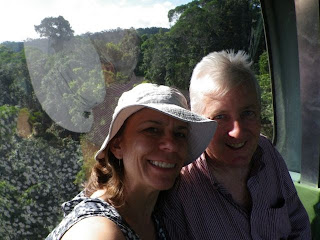I was talking to a friend from home last week, and she asked
me if we stand out as Americans here. I think not much. Neighbors who meet us
might say, “Oh, you’re the Americans on the corner.” I don’t think people would
know we were “from the states” until we opened our mouths because in
appearance, we don’t really look any different than most people here.
When we first arrived, it was suggested to us that when
asked where we were from, we might want to respond “California” instead of
“America.” The reasoning was that people who have negative stereotypes about
America often think “except for California.” This sentiment was confirmed by
our server at a very nice restaurant in Cairns. Lillianna is from Italy but is
living in Cairns with her husband. She began, as many store clerks and wait
staff do, by asking us where we were from. We responded, “California” and she
said, “The capitol is Sacramento!” Of
course we were impressed, and she continued, “Oh, I love people from
California. They are beautiful people. Oh, and Massachusetts too. But other states,
not so much. They are kind of self-centered, don’t you agree?” She proceeded to tell us a story about an
American woman who came to the restaurant. Their conversation went like this:
American woman: You told me all of the wines you serve are
from Australia.
Lillianna: Yes, ma’am, that’s correct.
American woman: But this says here this wine is from
Washington. That’s in the US.
Lillianna: No, ma’am, that WA stands for Western Australia.
American woman: Are you sure?
At a table near us there were five twenty-something men, two
of whom were from America. How did we know this? Because Lilliana asked them
where they were from and when two of them said Colorado and Oregon, she
proceeded to name their state capitals. (This may be an endearing strategy to
increase her chances of tips from those from a tipping culture in a non-tipping
country.) Unfortunately, the man from Denver repeatedly and loudly illustrated Lilliana’s
stereotype for non-CA and non-MA Americans.
One time a bus driver asked me if I was from Canada. I said,
“No, I’m from California.” And I added, “But I wouldn’t mind being from
Canada.” Then he revealed that he always asks people with North American
accents if they are from Canada, “because Americans are generally flattered by
that, but if you ask a Canadian if they’re American, they’re offended.” So, I
guess I had just proven that generalization correct.
Having shared those few experiences, I would say we have
been treated with great hospitality and generosity wherever we go. The most
noticeable superficial difference is in our language. Many of the terms in
Australia are British in spelling and flavour like boot (trunk) or biscuit (cookie).
I can’t manage to avoid capsicum (bell pepper), which is in just about
everything. We can usually figure out the meaning of a word we don’t know when
it’s used in context, but not always. Our neighbors invited us for Sunday tea,
which turned out to be a roast dinner, not just, as they say, a “cuppa.” We also learned “take a squizz” (have a
look) and “the council is being all argie bargie about it” (unnecessarily
difficult). There are also a number of words where different syllables are
emphasized. For example, macramé is pronounced here as mac-ram’-ay. And
aluminum is spelled aluminium and pronounced al-u-min’-ee-um. And then there
are all the words that are spelled and sound the same, but are quickly
pronounced with an Australian accent that can stop me up some days.
The most notable difference in cultural principles that I’ve
observed between here and the US is an underlying value of fairness. “Fairdinkum”
is a uniquely Australian term, which to be fair (ha), I’ve never actually heard
it in regular conversation, though the prime minister did use it one day on TV.
It’s used similarly to how we would say, “No, it’s really true!” but I think it
also represents the national value of the "right to a fair go."
We often hear the concept of fairness used in a variety of
contexts. I’ve heard it used in a few different types of TV adverts (that’s
Australian for advertisement :-). In one PSA for a new fire levy, the premise
of the whole piece was everyone should pay this levy because, “That’s just
fair.” Andy watched a judge lecture a juvenile in his court about his offense,
and he noted that what the kid did wasn’t fair. In sports, the MVP of a game is
called “The Best and Fairest.” From an American perspective, I think there’s
something fundamentally different about being “the most valuable” and being
“the fairest.” In practice, I think these phrases are meant to accomplish the
same thing. But language matters. And to me, fairness necessarily acknowledges
the quality of relationship between players. The term MVP connotes
standing out above the rest, or at least misses the explicit value of being
fair to others.
Even though people in Australia can be just as fanatic in
barracking (cheering) for their team as fans in the US, the spirit of
competition in the general culture feels kinder and gentler than in America.
Referees and umpires are generally treated with great respect and there’s a lot
of value placed on the spirit of the game, in addition to winning. I guess you
could say there’s a greater sense of fair play overall. That’s not to say that
all of the nation’s policies or actions are fair; both of our countries fall
short in achieving our own lofty ideals. But it feels like more Australians
believe in the value of fairness. As an American, that’s what stands out to me.


















































